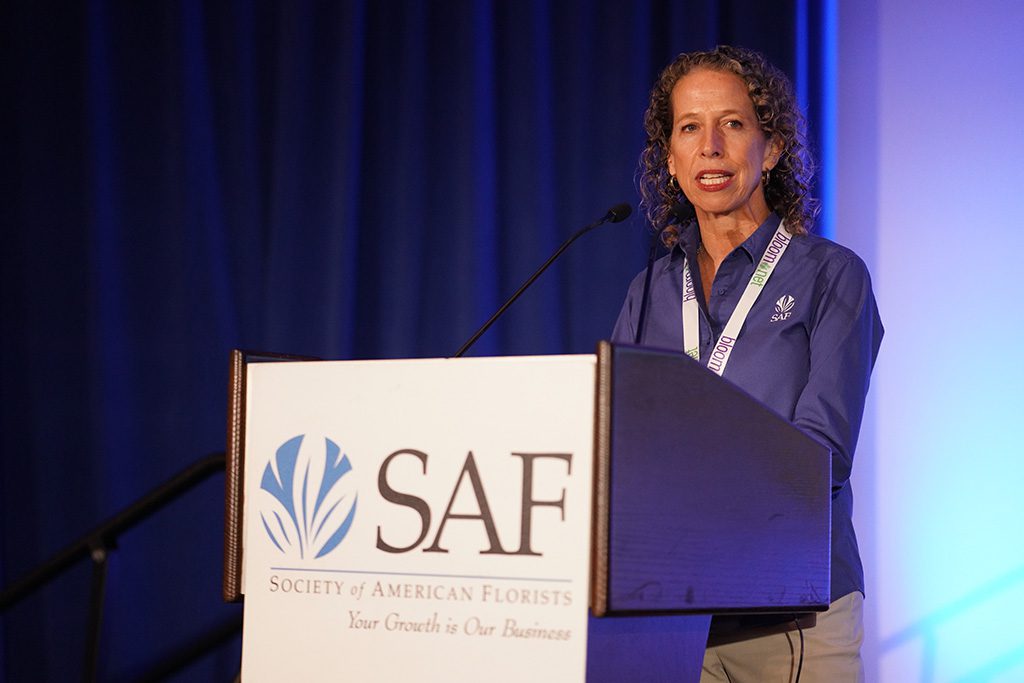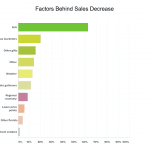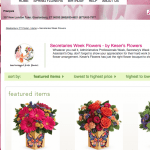
SAF CEO Kate Penn recapped how the floral industry has grown during the State of the Industry address at the association’s 137th annual convention in Orlando.
On the heels of two extraordinary years that brought double digit profits — as well as unprecedented challenges — a growing, fortified floral industry is well positioned to weather the headwinds of inflation and keep flowers top of mind for consumers.
That was the message that Kate Penn, CEO of the Society of American Florists, delivered during the State of the Industry address at SAF Orlando 2022, the 137th annual convention in Orlando, Florida.
“This two-year growth period has created an urgency about how we keep these flower buying customers,” Penn said. She identified several opportunities for florists to develop loyal customers through digital marketing and stellar customer service.
A Growing Industry
The floral industry is growing. From the number of imports to sales of U.S. grown crops and spending on floral products, the floral industry has grown and even hit records. Penn provided these statistics from a variety of sources, including the U.S. Department of Commerce, the USDA, and the Bureau of Economic Analysis:
- Average sales at retail flower shops are about $679,000. That average is expected to grow by 5 percent in 2023 and two percent for the next few years.
- Total spending on floral products from 2020 to 2021 grew 21.5 percent to $46.6 billion dollars.
- Sales of U.S. grown floriculture crops grew 16 percent from 2019 to 2021, hitting the $6 billion mark for the first time.
- More than a third of that is in annual bedding plants, followed by perennial plants and potted flowering plants, with about $1 billion in sales each. Cut flowers comprise $360 million in sales and cut greens are $105 million.
- There’s been an 8 percent increase in the number of growers, and that number doesn’t include the increase in flower and plant growers doing less than $100,000 in annual sales, which Penn said is significant.
- Imports to the U.S. also increased. Year to date, there has been 28 percent increase in dollar volume and a 15 percent increase in product volume of imported cut flowers, totaling $1.19 billion.
Keeping the Momentum
All that is positive news for the industry, and provides a strong foundation to keep the momentum going, Penn said. To that end, the industry has come together to collaborate on marketing initiatives to promote more consumption of flowers. One of those marketing campaigns, “Flowers. Self Care Made Easy,” was created by CalFlowers and launched earlier this year to promote more Americans enjoying flowers more often. Initial results from the campaign show that it influenced consumers’ feelings towards flowers.
Another marketing effort in the works is FloralBoard, and if it comes to fruition, it would create a national promotion for cut flowers, funded by an assessment of growers and importers.
Penn offered strategies for retail florists to build on the momentum created from COVID-19:
- Don’t underestimate what the consumer will spend. “It’s worth noting that while inflation may be influencing the consumer and what they spend, most florists are encountering little to no resistance to higher prices during the last year,” Penn said.
- Go above and beyond with your customer service. An Ipsos survey found that 81 percent of consumers are empathetic toward small business owners who raise prices due to inflation or shortages. That’s compared to only 47 percent who have empathy for large, multinational companies that increase prices for the same reasons. Customer service is key. About three quarters of customers reported they’d continue to buy from companies that increase their prices as long as they’re getting good customer service and the company makes them feel valued as a customer.
- Invest in online marketing and sales. The pandemic-era draw to shop online isn’t going away, and customers expect an easy, seamless online shopping experience. “Retailers and really all segments are embracing technologies that make those connections with customers and the entire shopping experience more convenient,” Penn said.
- Sell plants. Growers have amped up production, and plants have significant potential to draw in a consumer that retailers may otherwise not attract. “…Plants are firmly rooted as a part of our lifestyle,” Penn said.
- Tout the benefits of flowers and plants. Many retailers are building a wellness message into their marketing and capitalizing on the various SAF studies that show that flowers improve emotional and physical health.
- Find operational efficiencies. “What many owners and managers have discovered is that they can do more with fewer people,” Penn said. “And they have no intention of going back to previous staffing levels, even if there were the labor pool to support it.”
SAF Is Ready to Help
SAF, which represents all segments of the floral industry, from growers to importers and manufacturers to wholesalers and florists, is well positioned to help the industry connect and leverage those opportunities, Penn said.
SAF is connecting the industry with:
- Today’s talent. SAF held Next Gen LIVE!, an event planned by and held for the next generation of floral professionals. SAF also partners with Seed Your Future, which is working with businesses in the horticulture and floriculture industries to build a pipeline of talent.
- SAF’s events, courses and publications give members access to experts.
- SAF connects florists with their consumers through its local marketing resources and annual Petal It Forward event, coming up Oct. 19, in which florists give away two bouquets (or two stems) — one for the recipient to keep, and one to give away.
Amanda Jedlinsky is the managing editor of SAF NOW.



